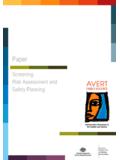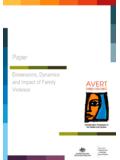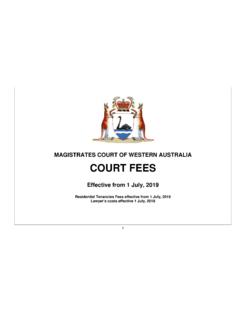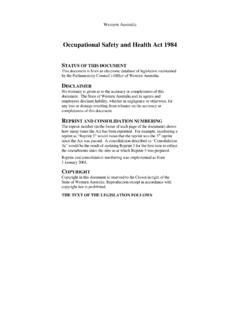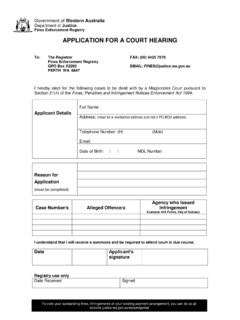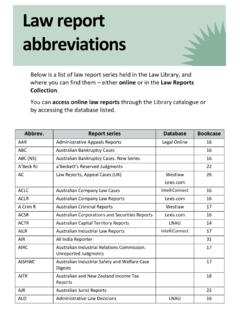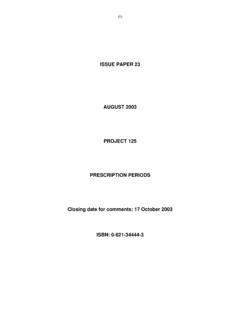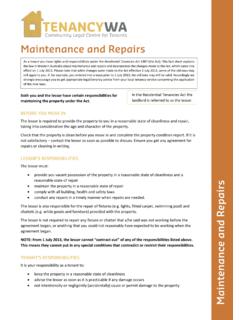Transcription of Screening, Risk Assessment and Safety Planning
1 screening and Risk Assessment Paper Paper screening , Risk Assessment and Safety Planning Copyright Commonwealth of Australia 2010 This resource is protected by copyright. Apart from any use as permitted under the Copyright Act 1968, and those explicitly granted below, all other rights are reserved. With the exception of the Commonwealth Coat of Arms and except where otherwise noted, all material presented in this training package is provided under a Creative Commons Attribution-No Derivative Works Australia licence The terms under which the Coat of Arms can be used are detailed on the It's an Honour website For the avoidance of doubt, this means this licence only applies to material as set out in this training package.
2 You must include the following link: when re-using or distributing this work so that it is clear to others that the Creative Commons licence applies to this copyright material. The details of the relevant licence conditions are available on the Creative Commons website (accessible using the links provided) as is the full legal code for the CC BY-ND AU licence Any reference to, reuse or distribution of all or part of this training package must be attributed in the following way: Australian Attorney-General s Department, AVERT Family Violence: Collaborative Responses in the Family Law System. Contact us Inquiries regarding the licence and any use of this resource are welcome at: Assistant Secretary Family Law Branch Attorney-General s Department 3-5 National Circuit Barton ACT 2600 Disclaimer The information presented and opinions expressed herein are those of the authors and do not necessarily represent the views of the Australian Government.
3 screening and Risk Assessment Paper Table of Contents A note on terminology used in this resource .. 1 Introduction .. 1 Risk factors associated with the perpetration of family violence .. 2 Risk factors Summary points .. 3 Context: the Family Law System .. 4 Identifying what constitutes family violence .. 6 screening , Risk Assessment , Safety Planning .. 7 What skills are needed to identify family violence? .. 7 screening .. 7 The benefits of screening .. 8 screening Protocols .. 10 When not to screen .. 10 How to conduct screening .. 11 When to ask the questions .. 11 Mailed questionnaires .. 11 Safety .
4 11 Risk Assessment .. 12 The benefits of risk Assessment .. 13 Risk factors .. 13 Lethality Assessment .. 15 Protective factors .. 15 The importance of victim information .. 16 Engaging Perpetrators in Risk Assessment .. 16 Engaging Children in Risk Assessment .. 17 Risk Assessment tools .. 18 Risk Management and Safety Planning .. 19 Implications for the family law system .. 20 Why use risk Assessment and screening tools .. 20 Service and support options in relation to family violence .. 22 Types of therapeutic or other interventions for working with family violence, their appropriateness and efficacy .. 23 Conclusion.
5 23 References .. 24 1 screening , risk Assessment and Safety Planning A note on terminology used in this resource Because this resource is designed for people working within the family law system, family violence is the chosen term throughout. It is a term that incorporates a broad range of intimate relationships in which abuse might be perpetrated, and it is the preferred term of Indigenous communities. Family violence also makes explicit the relationship between family violence and its implications for children in the family. Domestic violence is a term that has been widely used in the literature in this field and is therefore used in relevant contexts and quotations.
6 The phrase domestic and family violence is also used as it is the term used in legislation in some states and by some commentators. Introduction All professionals and services which play a role in the family law system need comprehensive, ongoing training in understanding and responding to domestic violence. This should include training about: the interconnectedness of the abuse of women and children; conducting risk assessments and developing Safety plans; the effects of trauma on women and children; the conditions that promote recovery from trauma; the dynamics of sexual and domestic violence perpetration; the risks and forms that post-separation violence can take; and the Assessment of claims of change in the perpetrators of abuse.
7 Laing (2010, p18): This paper is centrally concerned with the knowledge and procedures which will minimise risk and ensure the Safety of all involved in separation and family law services. It discusses screening of clients, risk Assessment with victims, perpetrators and children, and Safety Planning . The paper considers how these practices align with the designated roles and responsibilities of family law system staff including client services staff, family dispute resolution practitioners, registrars and legal practitioners. Relationship separation marks an increase in risk and degree of harm for victims of family violence (Braaf & Sneddon 2007 p.)
8 9). Accessing family dispute resolution, child contact or family court services, may also exacerbate risk for victims due to enforced contact or proximity, or be a flashpoint for a violent episode. At a minimum, accessing these services is likely to be stressful for victims and their children. It is because of the clear potential for family law service providers to meet clients at a time of increased risk that family violence is of central concern. screening , risk Assessment and Safety Planning are relatively new processes within the family law system. screening and Risk Assessment Paper Laing (2010 p17) has identified concerning knowledge gaps amongst family law system professionals.
9 Who failed to demonstrate understandings of both the complexities of domestic violence and its harmful effects of the development and well being of limited understanding of the forms that post separation domestic violence can of the impact of trauma on women and children and on the mother-child [and] how a woman may present in legal contexts; and of what is required to rebuild a relationship between a child and someone who has abused the trust inherent in the parent-child relationship. Bagshaw and Brown (2010 p7) concur: ..the problem remains that the family law socio-legal service system has not sought to place adult and child Safety after parental separation above all other principles, and unless it can move to do this family violence will remain an unresolved, serious problem for families who seek separation as a way of ending family violence, or who experience family violence as a result of separation.
10 Risk factors associated with the perpetration of family violence While there is no single cause or factor that leads to family violence, a number of risk factors or markers the characteristics that increase the likelihood of re-assault have been identified as being associated with perpetrators of family violence. These factors include: ..age, low academic achievement, low income or exclusion from the labour market, social disadvantage and isolation and exposure to, or involvement in, aggressive or delinquent behaviour as an of these same risk factors have been linked to an increased likelihood of aggressive behaviour and offending generally.
